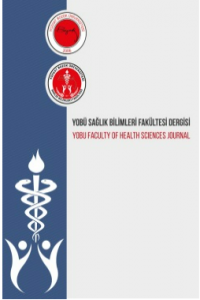HEMŞİRELERİN HASTA GÜVENLİĞİ KÜLTÜRÜNÜ ALGILAMA DÜZEYİ VE OLAY BİLDİRİM EĞİLİMİ
Amaç: Bu araştırma hemşirelerin hasta güvenliği kültürünü algılama düzeyini ve olay bildirim eğilimini belirlemek amacıyla
yapıldı.
Yöntem: Tanımlayıcı tasarımda yürütülen araştırmanın çalışma evrenini Doğu Anadolu Bölgesinde Sağlık Bakanlığı’na
bağlı bir hastanedeki tüm hemşireler oluşturdu (N=325). Araştırmada herhangi bir örneklem seçim yöntemi kullanılmadı,
ilgili hastanede en az altı aydır çalışan, araştırmaya gönüllü olarak katılmak isteyen ve araştırmanın yapıldığı tarihlerde izinli
olmayan tüm hemşireler araştırma kapsamına alındı (n=222). Araştırmanın verileri kişisel bilgi formu, hasta güvenliği
kültürü hastane anketi ve olay bildirim ölçeği kullanılarak toplandı. Verilerin analizinde sayı, yüzde, aritmetik ortalama,
standart sapma kullanıldı.
Bulgular: Araştırmaya katılan hemşirelerin çoğunun evli (%59.9), lisans mezunu (%49.1), servis hemşiresi (%62.6),
ortalama 28.38±5.79 yaşında, 6.34±5.87 yıl mesleki deneyime ve 3.21±3.63 yıl ilgili hastane deneyimine sahip olduğu
belirlendi. Hasta güvenliği kültürü ölçeği alt boyutlarından “üniteler içinde ekip çalışması” alt boyutunun en yüksek “hataya
karşı cezalandırıcı olmayan yanıt” alt boyutunun en düşük pozitif skor ortalamasına sahip olduğu ve hemşirelerin kurum
hasta güvenliği kültürünü %45.4 oranında pozitif olarak algıladıkları saptandı. Hemşirelerin olay bildirim eğilimine ilişkin
değerlendirmelerinin ise “iç bildirimde bulunma niyeti” alt boyutunun en yüksek (3.51± 0.93), “kayıtsız kalma” alt
boyutunun en düşük (2.07±1.02) puan ortalamasına sahip olduğu; %80.2’sinin hiç olay raporlamadığı belirlendi.
Sonuç: Araştırma sonucunda, hemşirelerin hasta güvenliği kültürü algılarının orta düzeyde ve olay bildirim eğilimlerinin
düşük-orta düzeyde olduğu belirlendi. Bu sonuçlar doğrultusunda hemşirelerin hasta güvenliği uygulamaları ile ilgili
farkındalık ve uygulamalarını artıracak eğitim programlarının yapılması, hasta güvenliği kültürünün yaygınlaşması ve iyi
uygulama örneklerini artırmak için tüm çalışanların hata raporlamaya ve olay bildirimine teşvik edilmesi önerilebilir.
Anahtar Kelimeler:
Hasta güvenliği, hasta güvenliği kültürü, hemşire, olay bildirim eğilimi
NURSES' PERCEPTION OF PATIENT SAFETY CULTURE AND ADVERSE EVENT REPORTING TENDENCY
Aim: This research was carried out to determine the level of nurses' perception of patient safety culture and their tendency to
report incidents.
Method: The study population of the research conducted in descriptive design consisted of all nurses working in a hospital
affiliated to the Ministry of Health in the Eastern Anatolia Region (N=325). No sampling method was used in the study, all
nurses who had been working at the relevant hospital for at least six months, who wanted to voluntarily participate in the
study, and who were not on leave on the dates of conducting the study were included in the study (n=222). The study data
were collected using a personal information form, event reporting scale and patient safety culture hospital questionnaire. For
analysis of the data, descriptive statistics number, percentage, arithmetic mean and standard deviation were used.
Results: It was determined that most of the nurses participating in the study were married (59.9%), undergraduate graduate
(49.1%), service nurse (62.6%), mean age of 28.38±5.79 years, 6.34±5.87 years professional experience and 3.21±3.63 years
of this hospital experience. From the patient safety culture scale subdomains, “teamwork within units” had the highest
positive mean score and “non-punitive response to error” had the lowest and the nurses perceived the institutional patient
safety culture as positive at a rate of 45.4%. The evaluations of the nurses regarding the tendency to report events, on the
other hand, showed that the "intention to report internally" sub-dimension had the highest (3.51±0.93) and the lowest
(2.07±1.02) point average of the "indifference" sub-dimension; It was determined that 80.2% of them did not report any
events.
Conclusion: As a result of the research, it was determined that nurses' perceptions of patient safety culture were moderate
and their event reporting tendencies were low-moderate. It can be suggested as a result of the study that training programs
should be arranged to increase the awareness of nurses in patient safety procedures and increase their good practice examples
and that all employees should be encouraged to report errors and incidents in order to spread patient safety culture and
improve practices.
___
- Referans1 Kuruthan M. Hasta Güvenliği Çözümleri Bir Uygulama Rehberi Denemesi, Sage Yayıncılık, Ankara, 2009:10-18.
- Başlangıç: 2020
- Yayıncı: Yozgat Bozok Üniversitesi
Sayıdaki Diğer Makaleler
EMZİK KULLANIMININ BEBEK SAĞLIĞINA ETKİLERİ
İlknur YILDIZ, Emine ALTUN YILMAZ, Şenay ARAS DOĞAN
ANNELERİN SEZARYEN DOĞUMUN ANNE VE ÇOCUK SAĞLIĞINA ETKİLERİ İLE İLGİLİ BİLGİ VE GÖRÜŞLERİ
Munise ÇUVALCI, Fatma GÜDÜCÜ TÜFEKÇİ
HEMŞİRELERİN HASTA GÜVENLİĞİ KÜLTÜRÜNÜ ALGILAMA DÜZEYİ VE OLAY BİLDİRİM EĞİLİMİ
Kübra TUNÇEL, Serap Mankaliye SÖKMEN
